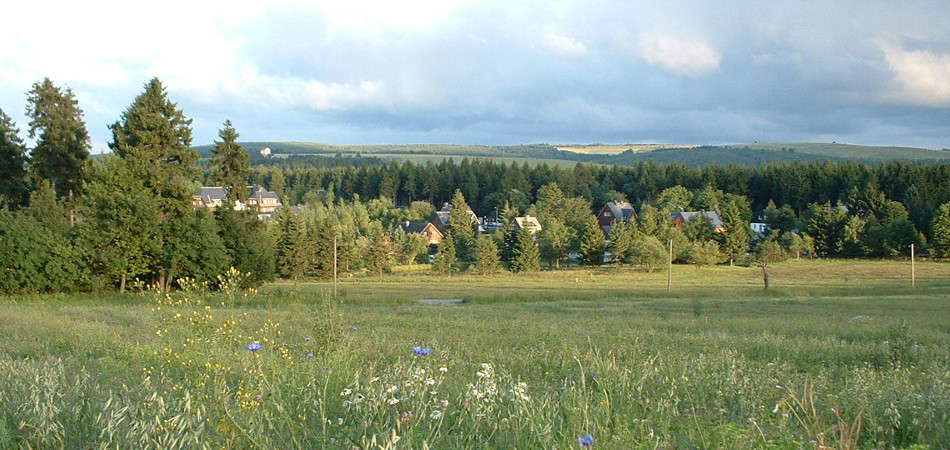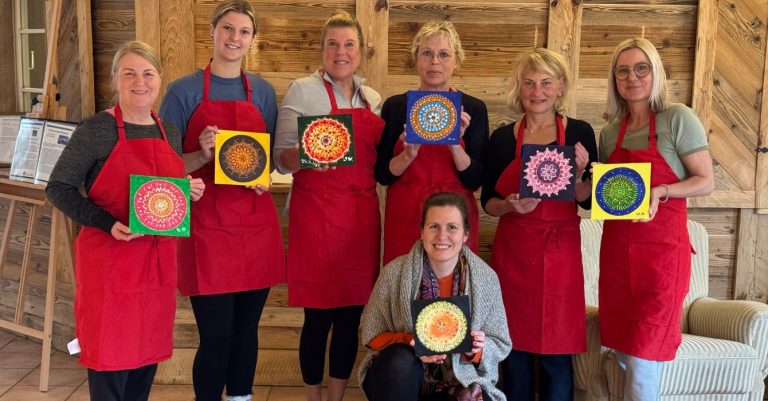Forest, meadows and climate around the customs house
Felix Förster leads hikes in the area around the customs house for guests who Alkaline fasting, Fasting hike or Yoga and hiking or guests who spontaneously book on site. He says that guests are often the first to comment on how green the forest and meadows are - even when, for example, there is drought just 30 kilometres away around Dresden or elsewhere in the German lowlands in summer.
Strikingly healthy appearance of the forest and fields
The healthy appearance of the region around Neuhermsdorf is partly due to the altitude. According to Felix, at an altitude of 700-800 metres, the amount of precipitation here is about three times that of the lowlands. This is sufficient for a healthy appearance of the forest, even during dry periods in Germany. There is less bark beetle infestation here than in regions such as the Harz Mountains or North Rhine-Westphalia, where sometimes a third to half of the forests dry out at certain times of the year, says Felix.
Subalpine climate despite lower altitude than in comparable climatic regions
At this altitude, the climate around the Zollhaus is also sub-alpine, comparable to the climate at 1200 metres in the German Alps or the Black Forest. The fact that we have a similar climate 400 metres lower down is due to the fact that we are located further east and therefore have a much more continental climate than the more westerly, maritime climate zones in Germany. That's why, explains Felix, despite the lower altitude, the Eastern Erzgebirge is perceived as having a mountain character.
Spruce and lark forests; but hardly any fruit trees
The forests are mainly characterised by spruce and larch. Beech trees are only found in certain locations, such as on south-facing slopes, and it is also too cold for oaks - they are not found here at all. Fruit trees have only been introduced to the region in recent years as the climate has become warmer. Traditionally, there were no fruit trees in the villages here, but people went "down into the valley" to trade for apples and other fruit.
As the winter here lasts about six months and snow can be found from October to May, there is only a short growing season. Winter is followed by a short spring, when the flowers and plants burst forth, and then summer immediately follows. Even in summer, the nights are cool. Due to the temperatures and the short growing season, only certain plants can grow here.
Animal husbandry instead of crop farming
In addition to the lack of fruit trees, there are also hardly any field crops. Only potatoes and barley were cultivated in the past; the main role in agriculture was played by animal husbandry, which is why large areas were used for grazing instead.
For many farmers, the decisive factor in livestock farming was how much hay they could produce on their land in summer in order to get as many animals through the long winter as possible. After all, they had to rely on hay feeding from October to May. After all, the animals helped to feed their household and labourers.
In order to produce as much hay as possible, all the trees on the grassland were pushed back to create what is known as a field cleanse. Trees would have cast shadows and less grass would have grown in these areas. This explains the clear divisions between forest, field and village in the appearance of the region.
Warmer climate brings changes in agriculture and summer tourism
In the last 15-20 years, however, we have seen some changes in regional agriculture. Since then, maize has been grown in the fields; in the last 10-15 years, wheat has also been added. Both were traditionally traded or bartered. Grass seeds are now also sown and used as green fodder for cows and other livestock. This is because it is still moist enough here in June and July for the grasses to ripen. This is increasingly no longer possible in the lowlands, as it becomes too dry there from July onwards and seeds no longer ripen or grasses dry out.
Climate change is therefore increasingly turning the Eastern Ore Mountains into a favourable location. In addition to the new agricultural opportunities, there are also advantages for summer tourism. Anyone looking for a summer retreat can climb a few hundred metres in altitude to escape the heat of the lowlands. This is also pleasant for residents. Until a few years ago, it was unimaginable to sit on a garden bench at night in the summer in lukewarm temperatures. Now it is increasingly possible to enjoy summer nights in just a light jacket.
Find more information about programmes with guided hikes here: Alkaline fasting, Fasting hike or Yoga and hiking.








